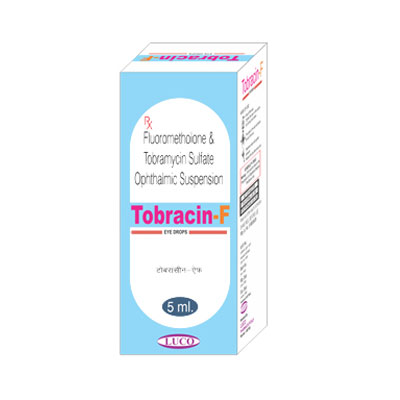
Tobramycin and Fluorometholone Ophthalmic Suspension. Tobracin F Ophthalmic Suspension is indicated for steroid responsive inflammatory ocular conditions for which a corticosteroid is indicated and where superficial bacterial ocular infection or a risk bacterial ocular infection exists.
Trade Name :
Tobracin F
Composition:
Each ml contains:
Tobramycin Sulfate USP eq. to Tobramycin Benzalkonium Chloride Solution 0.3% w/v+ FluorometholoneIP 0.1% w/v, Sterile Suspension Base q.s.
Dosage Form :
Eye Drops
Dosage and Method of Administration :
NOT FOR INJECTION. FOR EXTERNAL USE ONLY. SHAKE WELL BEFORE USE
One or two drops instilled into the conjunctival sac(s) every four to six hours. During the initial 24 to 48 hours the dosage may be increased to one or two every two (2) hours. Frequency should be decreased gradually as warranted by improvement in clinical signs. Care should be taken not to discontinue therapy prematurely or as per advice of the physician.
Indications :
Tobracin F ophthalmic Suspension is indicated for steroid responsive inflammatory ocular conditions for which a corticosteroid is indicated and where superficial bacterial ocular infection or a risk bacterial ocular infection exists.
Ocular steroids are indicated in inflammatory conditions of the palpebral and bulbar conjunctiva, cornea and anterior segment of the globe where the inherent risk of steroid use in certain infective conjunctivitis is accepted to obtain a diminution in oedema and inflammation. They are also indicated in chronic anterior uveitis and corneal injury from chemical radiation or thermal burns or penetration of foreign bodies.
The use of a combination drug with an anti-infective component is indicated where the risk of superficial ocular infection is high or where there is an expectation that potentially dangerous numbers of bacteria will be present in the eye.
The anti-infective drug in this product, tobramycin is active against the following common bacterial eye pathogens: Staphylococci, including S.aureus and S.epidermidis (coagulase-positive and coagulase-negative), including penicillin-resistant strains.
Streptococci, including some of the Group A beta-hemolytic species, some nonhemolytic species and some Streptococcus pneumoniae.
Psuedomonas aeruginosa, Escherichia coli, Klebsiella pneumoniae, Enterobacter aerogenes, Proteus mirabilis, Morganellamorganii, most Proteus vulgaris strains, Haemophilus influenzae and H.aegyptius, Moraxella lacunata and Acinetobacter calcoaceticus (Herelleavaginacola and some Neisseria species).
Pharmacological Properties :
Corticosteroid suppress the inflammatory responses to a variety of agents and they probably delay or slow healing. Since corticoids may inhibit the body’s defence mechanism against infection, a concomitant antimicrobial drug may be used when this inhibition is considered to be clinically significant. Clinical studies have demonstrated that Fluorometholone Suspensions is a potent corticosteroid.
In clinical studies of documented steroid-responders, fluorometholonedemonstrated a significantly longer average time to produce a rise in intraocular pressure than dexamethasone phosphate, however, in a small percentage of individuals, a significant rise in intraocular pressure occurred within one week. The ultimate magnitude of rise was equivalent for both drugs. The antibiotic component in the combination (tobramycin) is included to provide action against susceptible organisms.
In vitro studies have demonstrated that tobramycin is active against susceptible strains of the following microorganisms: Staphylococci, including S.aureus and S.epidermidis (coagulase-positive and coagulase-negative), including penicillin-resistant strains.
Streptococci, including some of the Group A beta-hemolytic species, some nonhemolytic species and some Streptococcus pneumoniae.
Psuedomonas aeruginosa, Escherichia coli, Klebsiella pneumonia, Enterobacter aerogenes, Proteus mirabilis, Morganellamorganii, most Proteus vulgaris strains, Haemophilus influenzae and H.aegyptius, Moraxella lacunata and Acinetobacter calcoaceticus (Herelleavaginacola and some Neisseria species). Bacterial susceptibility studies demonstrate that in some cases microorganisms resistant to gentamicin remain susceptible to tobramycin.
Bacterial resistance to tobramycin may develop upon prolonged use.
No data are available on the extent of systemic absorption from Tobracin F Ophthalmic Suspension: however, it is known that some systemic absorption can occur with ocularly applied drugs.
When a decision to administer both a corticoid and an antibiotic is made, the administration of such drugs in combination has the advantage of greater patient compliance and convenience, with the added assurance that the appropriate dosage of both is administered, plus assured compatibility of ingredients when both types of drugs are in the same formulation and particularly that the correct volume of drug is delivered and retained.
Warning and Precautions :
WARNINGS: NOT FOR INJECTION INTO EYE.>
Sensitivity to topically applied aminoglycosides may occur in some patients. If a sensitivity reaction does occur, discontinue use.
Use of ocular steroids may prolong the course and may exacerbate the severity of many viral infections of the eye. Prolonged use of steroids may result in glaucoma with damage to the optic nerve, defects in visual acuity and fields of vision and posterior sub capsular cataract formation. If used for more than 10 days, intraocular pressure should be routinely monitored even though it may be difficult in children and uncooperative patients. Prolonged use may suppress the host response and thus increase the hazard of secondary ocular infections. In those diseases causing thinning of the cornea or sclera, perforations have been known to occur with the use of topical steroids. In acute purulent conditions of the eye, steroids may mask infection or enhance existing infection.
Precautions : General: The possibility of fungal infections of the cornea should be considered after long-term steroid dosing. As with other antibiotic preparations, prolonged use may result in overgrowth of non-susceptible organisms including fungi. If superinfection occurs, appropriate therapy should be initiated. When multiple prescriptions are required or whenever clinical judgement dictates, the patient should be examined with the aid of a magnification such as slit-lamp bio microscopy and where appropriate fluorescein staining.
Do not touch dropper tip to any surface as this may contaminate the suspension. Tobracin F should not be administered while wearing soft contact lenses.
CONTRAINDICATIONS: Epithelial herpes simplex keratitis (dendritic keratitis), vaccinia, varicella and many other viral diseases of the cornea and conjunctiva, Mycobacterial infection of the eye, fungal diseases of the ocular structures and hypersensitivity to any component of the medication.
Undesirable Effects :
Adverse reactions have occurred with steroid/anti-infective combination drugs which can be attributed to the steroid component, the anti-infective component or the combination.
Exact incidence figures are not available. The most frequent adverse reactions to topical ocular tobramycin are localized ocular toxicity and hypersensitivity, including lid itching and swelling and conjunctival erythema. These reactions occur in less than 4% of patients. Similar reactions may occur with the topical use of other aminoglycoside antibiotics. Other adverse reactions have not been reported; however, if topical ocular tobramycin is administered concomitantly with systemic aminoglycoside antibiotics, care should be taken to monitor the total serum concentration. The reactions due to the steroid component are elevation of intraocular pressure (IOP) with possible development of glaucoma and infrequent optic nerve damage, posterior sub capsular cataract formation and delayed wound healing.
Secondary Infection: The development of secondary infection has occurred after use of combination containing steroids and antimicrobials. Fungal infections of the cornea are particularly prone to develop coincidentally with long-term application of steroids. The possibility of fugal invasion must be considered in any persistent corneal ulceration where steroid treatment has been used. Secondary bacterial ocular infection following suppression of host responses also occurs.
Shelf-Life :
2 Years
Packaging Information :
Product is packed in a 5 ml plastic bottle with a plastic nozzle pre sterilized and plastic cap.
Storage and Handling Instructions :
Store at room temperature. Protect from light.

OPHTHAL